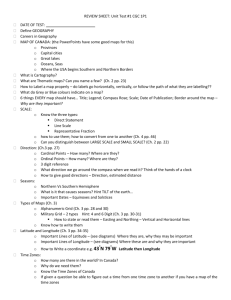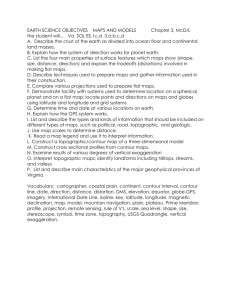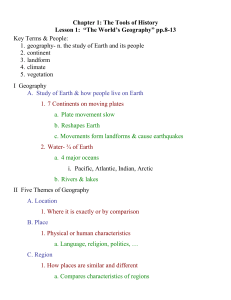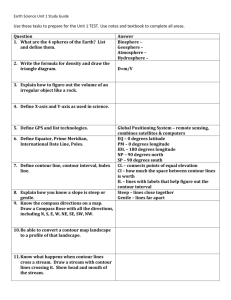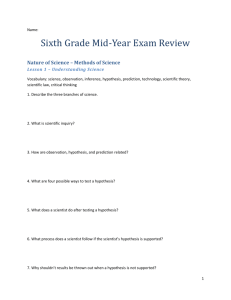Maps and Landforms Notes
advertisement
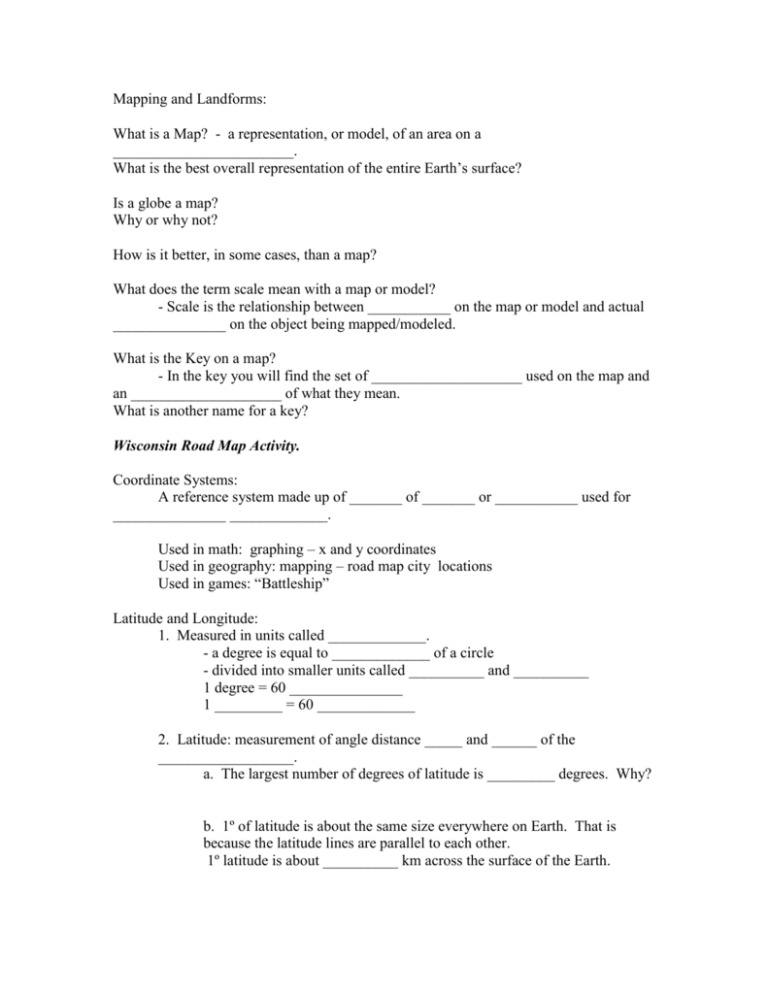
Mapping and Landforms: What is a Map? - a representation, or model, of an area on a ________________________. What is the best overall representation of the entire Earth’s surface? Is a globe a map? Why or why not? How is it better, in some cases, than a map? What does the term scale mean with a map or model? - Scale is the relationship between ___________ on the map or model and actual _______________ on the object being mapped/modeled. What is the Key on a map? - In the key you will find the set of ____________________ used on the map and an ____________________ of what they mean. What is another name for a key? Wisconsin Road Map Activity. Coordinate Systems: A reference system made up of _______ of _______ or ___________ used for _______________ _____________. Used in math: graphing – x and y coordinates Used in geography: mapping – road map city locations Used in games: “Battleship” Latitude and Longitude: 1. Measured in units called _____________. - a degree is equal to _____________ of a circle - divided into smaller units called __________ and __________ 1 degree = 60 _______________ 1 _________ = 60 _____________ 2. Latitude: measurement of angle distance _____ and ______ of the __________________. a. The largest number of degrees of latitude is _________ degrees. Why? b. 1º of latitude is about the same size everywhere on Earth. That is because the latitude lines are parallel to each other. 1º latitude is about __________ km across the surface of the Earth. c. The starting point for the measurement of latitude is the ____________________. Where is it? d. Another name for latitude lines is ________________. 3. Longitude: The measurement of angle distances _______ and _______ of the _________ ________________. a. the largest number of degree of longitude is _______________. Why? b. 1º Longitude varies in size across the Earth’s surface. It is largest at the _______________, equaling the size of 1º latitude at _____________________. It gets progressively smaller as you move away from the equator until, at the poles, it equals __________________. c. The starting point for the measurement of longitude is the ____________________ ____________________. Where is it? d. Another name for longitude lines is _________________________. Time Zones: define What do we base the measurement of time on? Daily: Yearly: If daily time is based on ______________________, then our clocks would need to change for every step we make either east or west. To prevent that we established ________________. If each time zone represents a 1 hour block, how many time zones are there on Earth? How wide is a time zone in degrees? Why? Why aren’t all time zones exactly _______ degrees wide? What time zone do we live in? How many time zones are there in the contiguous United States? How many in the total United States? What do we call the line directly opposite the Prime Meridian? This line was established because we needed a place for the day to change. It runs approximately down the middle of the time zone so it is the same time of day on both sides, just in a different day. How does the time change as you go across the International Date Line? As you go west across time lines it gets _______. As you go east across time lines it gets _______. So if you are as far west as you can get you are at the earliest time on Earth. If you are as far east as you can get you are at the latest time on Earth. If you cross the Date Line going west you go from _______ to _______. So, you go into ____________ and you just ________ today. (you _____ a day) If you cross the Date Line going east you go from _______to ________. So, you go into ___________ and you just _________ today over. (you ______ a day) Topography: define – Topographic maps – How can we show the topography on a map? 1. 2. 3. 4. Contour line maps What is a contour line? Rules for drawing contour lines 1. Contour lines form closed loops 2. Contour lines inside others are higher 3. Index Contours 4. Contour Interval 5. Contour lines don’t cross 6. Contour lines crossing rivers, valleys form “V” shaped notches pointing upstream Bathymetry - The _______________________ of the ________ ___________. - ACES activity Lesson 4 - Bathymetry model activity – simulation of echosounding technology. Landforms: See pg 10 for USA map of landforms Mountains – landform that rises _____________ above the _______________________________. a. fault-block b. folded c. upwarped d. volcanic Plateau – high elevation landform with a _________________________________. Plains – nearly flat landform at a ________________________________________. a. interior b. coastal Wisconsin Landforms 1. ____________________ – portion of the state landscape that we live in - ___________covering this area scoured away our landscape and deposited the hills of our region - ________________ - world famous region characterized by specific hills and depressions What is a kettle? What is a moraine? 1. terminal 2. lateral 3. drumlin 4. esker 5. kame What is a striation? Forces Changing our Landforms 1. Plate Tectonics – Theory and Fact a. Plate boundaries i. Convergent 1. subduction ii. Divergent iii. Transform 2. Weathering, Erosion, Deposition –define each a. Water i. Rain – force of rain on landforms is capable of weathering and eroding them over time ii. Glaciers – glaciers weather, erode, and deposit materials (we talked about this earlier in notes) iii. Frost action – water along with temperature changes, affects our roads as well as natural structures iv. Streams – the force of water in streams breaks up materials 1.) meanders - define 2.) Stream load – define Four parts to the stream load 1. In solution – 2. In suspension – 3. floatation – 4. Bed Load – b. Wind – “natural sandblaster” c. Gravity - landslides d. Animal activity i. burrowing animals ii. human activity – farming, construction, mining, road building
